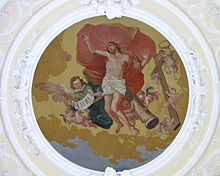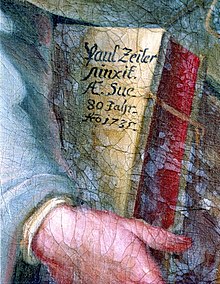Paul Zeiller
Paul Zeiller (also Zeiler ; born August 21, 1655 in Reutte ; † August 19, 1738 there ) was an Austrian baroque painter. From 1692 he ran a workshop in Reutte (later also "painting school"), in which his son Johann Jakob Zeiller (1708–1783) and his distant relative Franz Anton Zeiller (1716–1794) received their first drawing and painting lessons. After Zeiller's death in 1738, his son-in-law Johann Balthasar Riepp continued the workshop.
Family and education
Zeiller family members had been in the service of emperors and sovereigns for generations, including Paul Zeiller's younger brother Bernhard as valet at the court of Emperor Charles VI. in Vienna . Paul Zeiller was the fifth of nine children of Christoph Zeiller (* 1627). After completing a higher education, Paul is said to have aspired to become a clergyman one day. Around 1675, however, he rejected this plan and went to Florence , where he worked for several years as “Preceptor or Hofmeister” at the Medici court . There he met the court painter Livio Mehus (1630–1691) and often watched him at work. This in turn aroused in him “a strong inclination towards art”. After successful attempts at drawing and painting, Zeiller quit his job at court and devoted himself entirely to painting. He stayed with Mehus for some time and is said to have stayed in Rome for 16 years . But this is not the case, at least not in full. Because for the year 1682 there is reliable evidence that Zeiller received further training in Augsburg . Johann Georg Knappich (1637–1704) is particularly suitable as a teacher there . Afterwards, however, Zeiller actually stayed in Rome, where he liked it so much that he always intended to stay in the Eternal City. Because his dying mother wanted to see him again, Paul Zeiller returned to Reutte in 1692. He seriously planned to stay only a short time, but then spontaneously changed his entire life plan: on May 18, 1692, he married Regina Jäger in Breitenwang , and when his mother died on September 13, 1692, it had long been clear that he would be him wanted to spend future life in Reutte. Zeiller's first marriage had three children. Shortly after the birth of the third child, his young wife died on May 14, 1698. Circumstances forced the widower and three young children to quickly remarry. He married for the second time on November 24, 1698, this time with Anna Kurz. On September 26, 1699, their daughter Anna Maria was born, later wife of the painter Balthasar Riepp . Five more children followed, including Johann Jakob (born July 8, 1708), who was the only one of Paul Zeiller's sons to show “a strong tendency to paint”. The appointment of Zeiller as imperial court painter, reported by Leu, has not yet been confirmed. What is certain, however, is that Paul Zeiller was entrusted with the office of mayor of Reutte in 1710. In contrast to reports to the contrary, he is said to have performed his official duties conscientiously.
Zeiller left behind a wealth of works, including three cycles of the stations of the cross, which were created between 1733 and 1738, the year of his death. The large high altar sheet for the parish church of Berwang attests to its real age with the signature: "Paul Zeiller painted it when he was 80 years old in 1735". Thus he was born in 1655 and not as previously assumed in 1658 (the addition of the baptism date August 21 in the parish of Breitenwang was not added until 1658).
Practice and style
In contrast to some baroque painters, who made the process of finding a picture easier or saved it with the help of prints, Zeiller usually thought up his own picture compositions. The figural conceptions found in this way then return in varied ways in depictions with the same title. Style and painting technique remained practically unchanged over a period of four decades. Zeiller remained stylistically indebted to his teacher Livio Mehus and a special Augsburg local style. Paul Zeiller also worked exclusively as a panel painter . In this profession he also possessed unlimited ability. He mastered neither the sophisticated technique of the fresco nor its soffit. His only known attempt to paint on the ceiling has been preserved in Breitenwang's Church of the Resurrection. The eight small-format, stucco-framed pictures in tempera painting technique are all made in a panel-like form. In the last years of the 17th century, Paul Zeiller set up a panel painting school in his workshop, which soon also attracted students to Reutte - many and some good ones. During the training, manual skills were always in the foreground.
Catalog raisonné
All early works that were created before 1695 have been lost. The many later pictures, usually painted on canvas, cannot be listed here individually. Only the most important works are named with their location and year of origin. Only some of them are still "in situ", i.e. at the original location, some have been disfigured by renovations, others have been lost.
- 1695: Biberwier , parish church, two former side altar leaves
- Around 1698/99: Sonthofen , cemetery chapel, former high altar sheet
- 1699: Oberstdorf , parish church, high altar sheet with extract
- 1699: Aitrang , parish church, former high altar sheet
- 1702: Breitenwang , deanery parish church, four altarpieces
- 1704: Wängle , parish church, two high altar leaves
- 1704: Aitrang -Görwangs, pilgrimage church, altar leaves
- 1705: Vils , parish church, altarpieces
- 1707: Oy-Mittelberg, pilgrimage church Maria Rain , altar leaves
- 1707/08: Schöllang, castle church , two altar leaves and extracts
- 1710/11: Nesselwang , former parish church, altar leaves
- 1712: Markdorf , hospital church, altar leaves and gallery pictures
- 1713/14: Breitenwang , deanery parish church, gallery pictures
- 1714: Bayerniederhofen , parish church, high altar sheet
- Around 1715: Füssen- Weißensee , parish church, high altar sheet and extract
- 1716–1728: Füssen, formerly the Benedictine Abbey of St. Mang, chapter house, 29 oval pictures
- 1717–1728: Ottobeuren, Benedictine Abbey , cloister, unknown number of oval pictures (47 preserved)
- 1719: Rückholz , parish church, high altar sheet
- Between 1720 and 1725: Innsbruck- Wilten , rectory, two panel paintings
- 1724: Tannheim , parish church, two side altar leaves
- 1724/25: Lana -Gagers, chapel, two side altar leaves
- Between 1724 and 1728: Breitenwang , Church of the Resurrection, eight ceiling paintings in tempera painting technique
- Around 1725: Füssen- Weißensee , parish church, two side altar leaves and extracts
- 1728: Füssen , St. Sebastian branch church, side altar sheet and extract
- 1730: Holzen , former Benedictine convent, panel painting
- Around 1730: Füssen, Franciscan monastery , 10 vertical oval pictures
- Around 1730: Tarrenz -Obtarrenz, chapel, choir altar sheet
- Between 1732 and 1738: Bichlbach- Lahn, parish church, 14 stations of the cross
- Between 1732 and 1738: Vils , parish church, 14 stations of the cross
- Between 1732 and 1738: Elbigenalp , parish church, 14 stations of the cross
- 1735: Berwang , parish church, former high altar sheet
- 1736/37: Reutte, Franciscan monastery , panel paintings
Individual evidence
- ^ Gruber, Schmid-Pittl: Dean parish church hll. Peter and Paul. In: Tyrolean art register . Retrieved June 23, 2020 .
- ↑ Entry in the artist register of the Swiss sculptor Johann Carl Zay: "… my dear friends in Augusta [= Augsburg], 9th day may 1682 Paullo Zeillir maller gsell" (Mair, p. 8).
- ^ Franz Thomas Leu (1756-1800), a student of Johann Jakob Zeiller, wrote a biography of Paul Zeiller, which Johann Georg Meusel published (see literature).
- ↑ Leu claimed that Zeiller had never appeared for a meeting (Mair, p. 14).
- ↑ Leu states that Zeiller worked “even in his 77th year without glasses, very juicy, big and clean” (Mair, p. 49).
literature
- Franz Thomas Leu (from Braz / Vorarlberg), in: New Museum for Artists and Art Lovers, ed. by Johann Georg Meusel, 3rd piece, Leipzig 1794, pp. 315–321.
- Hans Semper: Zeiller, Paul . In: Allgemeine Deutsche Biographie (ADB). Volume 45, Duncker & Humblot, Leipzig 1900, pp. 645-649.
- Josef Mair: Paul Zeiller, "noble gentleman in Reutte - painter and mayor", 1658–1738 , Reutte 2008, ISBN 978-3-9502282-3-6
- Klaus Wankmiller: In the footsteps of Paul Zeiller - series with individual works in 25 episodes, in: Museum insights from the Museum Association of the Reutte District 2005 to 2018.
- Klaus Wankmiller: Paul Zeiller (1658 - 1738). On the 350th birthday of the founder of the Reutten painter dynasty - Part I , in: Tiroler Heimatblätter 83 (2008) No. 2, pp. 84–88.
- Klaus Wankmiller: Paul Zeiller (1658 - 1738). On the 350th birthday of the founder of the Reutten painter dynasty - Part II , in: Tiroler Heimatblätter 84 (2009) No. 1, pp. 31–35.
| personal data | |
|---|---|
| SURNAME | Zeiller, Paul |
| ALTERNATIVE NAMES | Zeiler, Paul |
| BRIEF DESCRIPTION | Austrian baroque painter |
| DATE OF BIRTH | August 21, 1655 |
| PLACE OF BIRTH | Reutte |
| DATE OF DEATH | August 19, 1738 |
| Place of death | Reutte |















